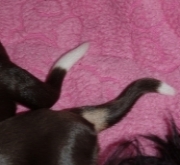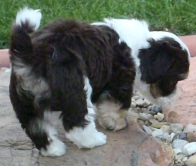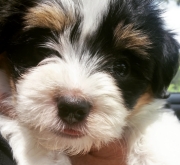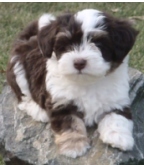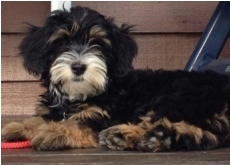
POINTS OF CONFUSION - Point Patterns
Point patterns cause a lot of confusion for a number of reasons. The first is that points are obscured as the coat grows out. The second is that the points often fade or soften in colour leaving a Tan point dog with no visible tan on it at all. Point patterns, as most Havanese patterns, are best identified on young puppies although certain points are easily distinguished on adult dogs as well.
Points
While white markings have infinite variety, the point pattern is much more specific. Points are lighter markings on an otherwise darker dog. Familiar dogs that have points are the Doberman and Rottweiler. Points are a distinct and recognizable pattern with markings in specific areas: eyebrows, inner ears, cheeks, chest, feet/legs, and vent.
Points can be any colour from pale cream, to gold, tan, silver or even brindled. Where the points are very light, or where they have been affected by other genes, it's easy to mistake them for white markings. There are some clues (see below) to help you figure things out.
Tan point Silver point
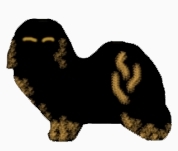
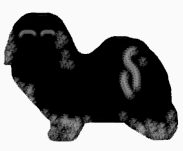
Tan point / silver point
Points are most common on black or chocolate dogs but they may also be found on dark silver, sable, or brindle dogs. The points of a Black & Tan, or tan-point Havanese, are any shade of tan, gold or red. The points can be clear or brindled. The chinchilla gene can lighten tan points to pale gold or creamy off white. The points of a Black & Silver, or silver-point Havanese, are any shade of silver or pewter. The points can be clear or brindled. The silvering gene can lighten silver points to pale platinum or off-white.
Black/white/tan Black/white/silver
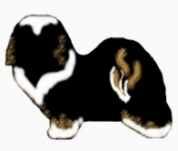
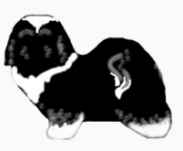
Tricolour
Tricolour generally refers to a dog that is Black/White/Tan, but it is also commonly used to mean any dog with three colours. As it pertains to points, a tricolour may be any dark colour dog, with any degree of white that is also sporting a third colour as a tan or silver point pattern. Think of it as starting with a particolour or Irish pied dog and then adding on points. You could end up with Black/White/Silver, or Sable/White/Tan or Chocolate/White/Tan etc.
Spot the points
Points are not always present at birth but generally develop within a few weeks. Look for vent markings (the area under the tail). This is an uncommon spot for white markings to appear on an otherwise dark dog, but is trademark for a point pattern. See the spot of bright tan under this puppy's tail, this is a Tricolour. From the rear, a puppy with vent markings will look like he has a tan or silver streak up the rear. Even without seeing the face and front, the pale golden stripe under the tail should give you a clue. Can you also see the golden eyebrows, gold cheeks and gold leg and foot?
On the face, points can be found on the eyebrows, inner ears, and cheeks. The puppy on the left displays bright gold markings. Not all tan markings will be this intense. They range from pale golden colour to bright red/orange. The puppy on the right is chocolate with more moderately coloured tan eyebrows.
Points vary in extent from small crescents or points of colour to large splashes. While our own tri-colour boy Otto sports just a single golden cuff on his right leg, Gaia from Norway goes all out with full tan leggings. Gaia has very strongly coloured and extensive tan points contrasted with a brilliant white muzzle.
NEXT ... Silver vs. Blue
